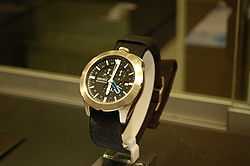Spring Drive

The Spring Drive is a watch movement that was developed by Seiko Epson[1] through collaboration with Seiko Instruments and Seiko Holdings. Up-to-date, it is the only commercially available wristwatch embedded technology capable of truly creating a continuous movement of the second hand, instead of the traditional beats per time unit as seen in quartz or mechanical watches.
It uses a mainspring, barrel, automatic winder and stem winding like in a mechanical watch to store the watch energy. The conventional escapement is replaced with a device that Seiko calls a Tri-synchro Regulator to regulate the unwinding of the mainspring. The regulator controls the use of the three forms of energy used in the Spring Drive mechanism; the mechanical power of the mainspring, the electrical energy generated from this mechanical power, and the electromagnetic energy that governs the rotation of the glide wheel. The energy produced by the glide wheel is used to power a control circuit and quartz crystal oscillator, which in turn regulates the electro-mechanical braking of the glide wheel.
The glide wheel's speed is sampled 8 times per second (i.e. each time it makes a complete revolution around the regulator) and compared with the reference quartz signal by the circuit. A variable braking force is continuously applied to regulate the glide wheel's frequency. This is the only movement with a time-only feedback (or phase-locked) loop in existence today.
The Tri-synchro Regulator's innovations result in a watch where the hands glide instead of ticking as in a conventional mechanical or quartz watch. This is because the movement never stops as in a traditional escapement, it is slowed to the proper speed by the brake. The movement is specified to 1 second accuracy per day. However, 1-2s per week is commonly reported by owners.
The movement is used on the Spring Drive International collection and in some watches of Grand Seiko, Credor, Galante, Izul, Ananta and Prospex series. Complications include moon phase, power reserve, chronograph, sonnerie, GMT and calendar functions. These watches are fairly expensive, with the least complicated models costing several thousand dollars. The top of the line is the Credor Minute Repeater in rose gold priced at 33 million yen (over $400,000 USD) and can be considered a grand complication.
History
The design was first conceived by Yoshikazu Akahane at Suwa Seikosha (currently Seiko Epson) in 1977, and patents were applied for in 1982. In total, no less than 230 patents have been applied worldwide for this movement. The movement was announced publicly in 1997, presented at the 1998 Basel Watch Fair and first appeared commercially in the Credor 'luxury watch' range as a limited edition in 1999. A version which included an automatic winder was shown in Seiko models at the 2005 Basel Watch Fair. The internationally available Seiko models were officially launched at the Musée d'Orsay in Paris on September 14, and went on sale the following day.
Swatch's research company ASULAB has developed a conceptually similar movement called the High Precision Mechanics movement. . Several proof of concept prototypes based on the ETA 2824 caliber were produced in the late 1990s.
Seiko's efforts with the Spring Drive predates ASULAB's HPM, since Spring Drive watches were already on sale in 1999.
Calibers

Early models, manual wind and 48h power reserve:
- 7R68 : 30 jewels, date.
- 7R78 : 30 jewels, date.
- 7R88 : 30 jewels, date.
- 7R99 : 32 jewels.
Current calibers, with standard features. Time accuracy: monthly rate within ±15 sec (equivalent to a daily rate of ±1 sec) and power reserve (72h) indicator.
- 5R64 : 32 jewels, date, small seconds hand.
- 5R65 : 30 jewels, date.
- 5R66 : 30 jewels, date, GMT.
- 5R67 : 30 jewels, Moon Phase indicator.
- 5R86 : 50 jewels, date, GMT, Chronograph.
- 7R06 : 88 jewels, Sonnerie.
- 9R65 : 30 jewels, date.
- 9R66 : 30 jewels, date, GMT.
- 9R86 : 50 jewels, date, GMT, Chronograph.
Notes and references
- ↑ Milestone Seiko/Credor Spring Drive Milestone Products, Seiko Epson
External links
- Spring Drive site.
- Truth of SPRING DRIVE
- SEIKO Technology: Spring Drive
- http://www.seikospringdrive.de/